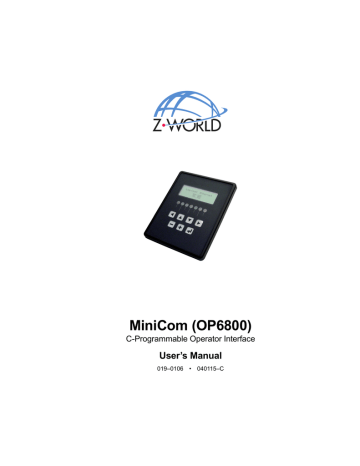- No category

advertisement

2.7 PONG.C
You are now ready to test your programming connections by running a sample program.
Find the file
PONG.C
, which is in the Dynamic C
SAMPLES
folder. To run the program, open it with the
File
menu (if it is not still open), compile it using the
Compile
menu, and then run it by selecting
Run
in the
Run
menu. The
STDIO
window will open and will display a small square bouncing around in a box.
This program shows that the CPU is working. The sample program described in
Section 5.2.3, “Run the PINGME.C Demo,” tests the TCP/IP portion of the board (if you
have the OP6800 model—the OP6810 does not have an Ethernet capability).
2.8 Where Do I Go From Here?
NOTE: If you purchased your OP6800 through a distributor or Z-World partner, contact the distributor or Z-World partner first for technical support.
If there are any problems at this point:
•
Check the Z-World Technical Bulletin Board at www.zworld.com/support/bb/.
•
Use the Technical Support e-mail form at www.zworld.com/support/support_submit.html.
If the sample program ran fine, you are now ready to go on to explore other OP6800 features and develop your own applications.
The following sample programs illustrate the features and operation of the OP6800.
OP6800
(
SAMPLES\LCD_KEYPAD\122x32_1x7
)
Demonstration Board
(
SAMPLES\OP6800\DEMO_BD
)
KEYBASIC.C
KEYMENU.C
SCROLLING.C
TEXT.C
KEYPAD.C
SWITCHES.C
These sample programs can be used as templates for applications you may wish to develop.
Chapter 3, “Subsystems,” provides a description of the OP6800’s features, Chapter 4,
“Software,” describes the Dynamic C software libraries and describes the sample pro-
grams, and Chapter 5, “Using the TCP/IP Features,” explains the TCP/IP features and
describes some sample programs.
User’s Manual 13
14 MiniCom (OP6800)
3. S
UBSYSTEMS
Chapter 3 describes the principal subsystems for the OP6800.
Figure 7 shows these Rabbit-based subsystems designed into the OP6800.
SRAM
Flash
32 kHz osc
11 MHz osc
RABBIT
2000
RS-232
Decoder
Keypad
Display
RabbitCore Module
Figure 7. OP6800 Subsystems
RS-485
Digital
Input
Digital
Output
User’s Manual 15
advertisement
Related manuals
advertisement
Table of contents
- 5 1.1 Description
- 5 1.2 Features
- 6 1.3 Development and Evaluation Tools
- 6 1.3.1 Tool Kit
- 7 1.3.2 Software
- 8 1.4 CE Compliance
- 9 1.4.1 Design Guidelines
- 9 1.4.2 Interfacing the OP6800 to Other Devices
- 11 2.1 Connections
- 14 2.2 Demonstration Program on Power-Up
- 14 2.3 Display Contrast Adjustment
- 15 2.4 Programming Cable Connections
- 16 2.5 Installing Dynamic C
- 16 2.6 Starting Dynamic C
- 17 2.7 PONG.C
- 17 2.8 Where Do I Go From Here?
- 20 3.1 Pinouts
- 21 3.2 Digital I/O
- 21 3.2.1 Digital Inputs
- 22 3.2.2 Digital Outputs
- 23 3.3 Serial Communication
- 23 3.3.1 RS
- 23 3.3.2 RS
- 25 3.3.3 Programming Port
- 26 3.3.4 Ethernet Port (OP6800 models only)
- 27 3.4 Memory
- 27 3.4.1 SRAM
- 27 3.4.2 Flash Memory
- 28 3.5 Keypad Labeling
- 32 4.1 Programming Cable
- 32 4.1.1 Switching Between Program Mode and Run Mode
- 32 4.1.2 Detailed Instructions: Changing from Program Mode to Run Mode
- 32 4.1.3 Detailed Instructions: Changing from Run Mode to Program Mode
- 33 4.2 OP6800 Libraries
- 34 4.3 Sample Programs
- 34 4.3.1 Board ID
- 34 4.3.2 Demonstration Board
- 35 4.3.3 Digital I/O
- 35 4.3.4 Serial Communication
- 35 4.3.5 LCD/Keypad Module Sample Programs
- 36 4.3.6 TCP/IP Sample Programs
- 37 4.4 Font and Bitmap Converter
- 39 5.1 TCP/IP Connections
- 41 5.2 TCP/IP Sample Programs
- 41 5.2.1 How to Set IP Addresses in the Sample Programs
- 42 5.2.2 How to Set Up your Computer’s IP Address for a Direct Connection
- 43 5.2.3 Run the PINGME.C Demo
- 43 5.2.4 Running More Demo Programs With a Direct Connection
- 44 5.2.5 LCD/Keypad Sample Programs Showing TCP/IP Features
- 45 5.3 Where Do I Go From Here?
- 47 6.1 Installation Guidelines
- 48 6.2 Mounting Instructions
- 48 6.2.1 Bezel-Mount Installation
- 52 A.1 Electrical and Mechanical Specifications
- 55 A.2 Conformal Coating
- 56 A.3 Jumper Configurations
- 57 A.4 Use of Rabbit 2000 Parallel Ports
- 59 A.5 I/O Address Assignments
- 61 B.1 Power Supplies
- 62 B.2 Batteries and External Battery Connections
- 62 B.2.1 Battery-Backup Circuit
- 63 B.2.2 Power to VRAM Switch
- 63 B.2.3 Reset Generator
- 64 B.3 Chip Select Circuit
- 66 C.1 Mechanical Dimensions and Layout
- 67 C.2 Power Supply
- 69 C.3 Using the Demonstration Board
- 74 D.1 Board Initialization (OP68xx.LIB)
- 75 D.2 Digital I/O (OP68xx.LIB)
- 76 D.3 Serial Communication (OP68xx.LIB)
- 78 D.4 LEDs (OP68xx.LIB)
- 79 D.5 LCD Display
- 96 D.6 Keypad